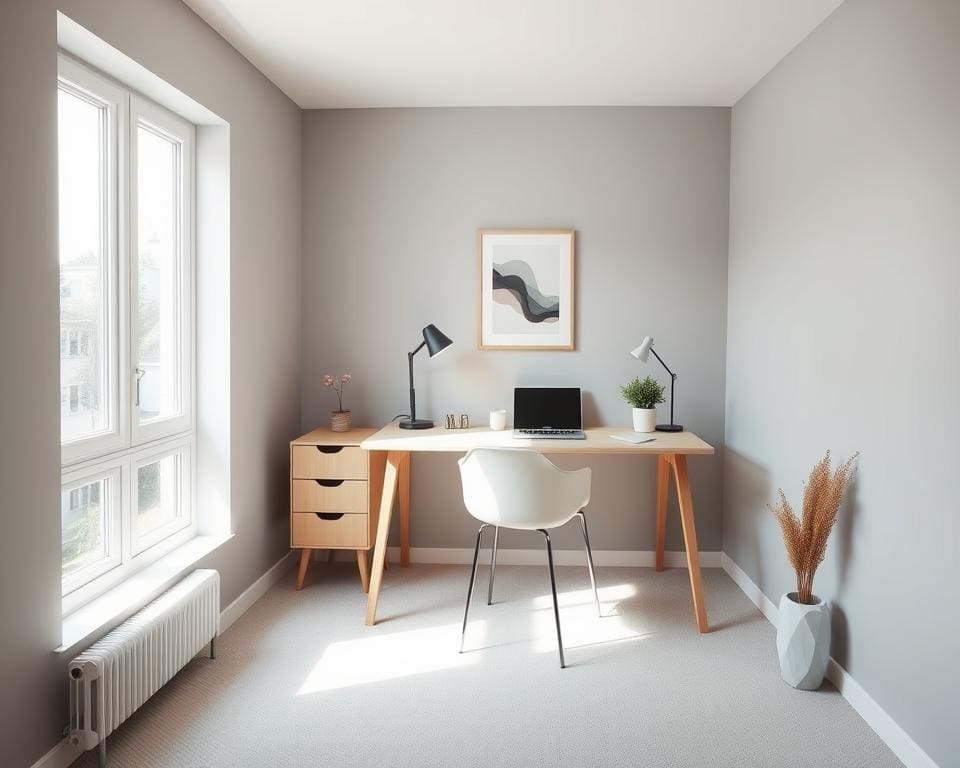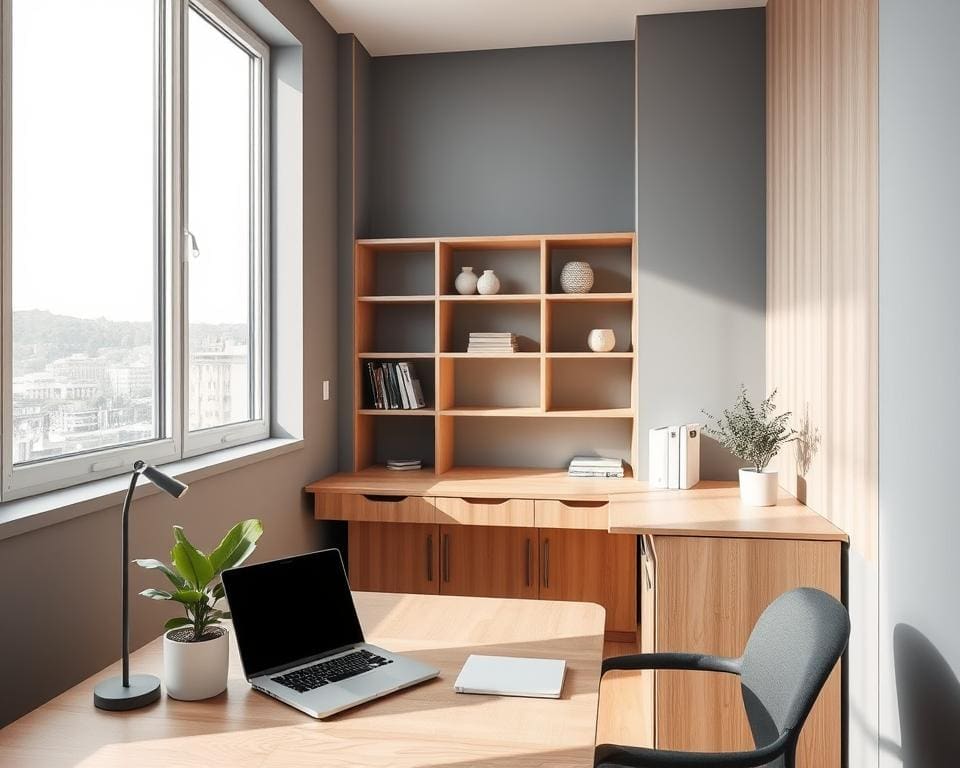In an age where remote work and urban living dominate, understanding what are practical ideas for a compact workspace has become increasingly essential. Limited space should not lead to a lack of functionality or style, as innovative compact workspace ideas can optimise every inch of your small office setup. This section explores how to create an efficient and inspiring work environment that maximises productivity, even in minimal areas. Embrace the challenge of designing a workspace that embodies both practicality and aesthetics, paving the way for a more enjoyable and effective work experience.
Understanding the Need for a Compact Workspace
The demand for compact workspaces is increasingly apparent in the UK, particularly as remote work becomes more prevalent. Creating a small office setup not only maximises efficiency but also promotes organisation and focus. Homeowners and renters recognise the need for sustainable living and strategic resource utilisation. Implementing thoughtful design can transform limited areas into productive environments.
Adopting compact workspace ideas leads to numerous advantages. Cost-effectiveness plays a crucial role, reducing expenses related to larger office spaces, utility bills, and maintenance. By embracing a smaller setting, individuals can declutter their surroundings, fostering a clearer mindset and enhancing productivity.
Many find that a well-structured workspace contributes significantly to overall well-being. Implementing productive home office tips can create a harmonious work-life balance, allowing for better concentration and creativity. A carefully designed compact workspace is not just about size; it’s about utilising every inch effectively and ensuring a space that invigorates the mind.

What are practical ideas for a compact workspace?
Creating a compact workspace requires an understanding of how to make the most of limited space. Practical workspace ideas can transform even the smallest areas into efficient environments for productivity. Incorporating elements that offer versatility and clever organisation is essential for successful workstation setup.
Optimising Space Usage
Efficient workspace design begins with furniture selection. Opt for multi-functional pieces like desks with built-in storage or shelves that can double as work surfaces. Creative layouts can enhance space usage; consider placing a corner desk to utilise every inch of your workspace. Wall-mounted storage can keep necessary supplies within reach while minimising clutter, fostering practical workstation organisation.
Benefits of a Compact Workspace
A compact workspace can lead to numerous advantages. Increased efficiency is one major benefit, as everything is typically within arm’s reach, allowing for streamlined workflow. This environment aids in maintaining focus, reducing distractions connected to larger, less organised spaces. With the right setup, one can cultivate a heightened sense of organisation, transforming a small area into a hub of creativity and productivity.
Essential Elements of Small Office Setup
Creating an effective small office setup requires careful consideration of essential elements that will enhance productivity. Choosing the right desk and storage solutions plays a crucial role in making the best use of limited space. By focusing on both functionality and style, individuals can design a workspace that inspires creativity and efficiency.
Desk Selection and Placement
The desk serves as the centrepiece of any small office setup. Opting for compact office furniture, such as wall-mounted or L-shaped desks, allows one to maximise space while ensuring comfort. Positioning the desk near natural light sources can foster a more inviting atmosphere and promote well-being. Thoughtful placement draws attention to the workspace, making it more enjoyable to work within.
Storage Solutions for Small Offices
Effective storage solutions are vital for maintaining an organised environment. Modular shelving can create vertical storage that utilises wall space efficiently. Under-desk storage options, such as roll-out drawers or compact filing cabinets, provide ease of access to important documents and supplies. Additionally, using creative containers to manage smaller items adds to the aesthetic while promoting a clutter-free workspace.
Space-Saving Office Solutions
Embracing space-saving office solutions transforms limited areas into efficient, productive zones. When considering how to make the most of a compact workspace, multi-functional furniture plays a pivotal role. These innovative pieces can adapt to various needs, allowing for practical workstation organization without sacrificing essential functionality.
Multi-functional Furniture
Investing in multi-functional furniture opens up numerous possibilities without overwhelming a small area. Consider foldable desks that can be stowed away when not in use or convertible sofas that double as workspaces. Storage ottomans not only provide seating but also offer a hidden compartment for office supplies. Such furniture aligns perfectly with compact workspace ideas, making them invaluable for anyone seeking to maximise their available space.
Vertical Storage Options
Utilising vertical storage options is essential for maintaining an organised working environment. Wall-mounted shelves can creatively display books and decorative items while keeping surfaces clear. Pegboards serve as an excellent way to hang tools or accessories, contributing to practical workstation organization. Incorporating these storage solutions allows for a tidy, functional workspace, capitalising on the often-overlooked vertical space available.
Creating a Productive Home Office Environment
Establishing a productive home office requires careful consideration of various environmental factors. By focusing on lighting and greenery, individuals can cultivate an efficient workspace design that fosters motivation and creativity. Natural and artificial lighting significantly impact mood and efficiency, while plants bring a touch of nature that can enhance well-being within compact workspace ideas.
Lighting Considerations
Good lighting is essential in any workspace, particularly in a home office where distractions abound. The right type of lighting can energise the space and improve focus. Consider using adjustable LED desk lamps that provide warm light conducive to concentration. Position your desk near a window to incorporate natural light, which boosts mood and productivity.
Incorporating Greenery
Adding plants to your workspace offers numerous benefits. Studies show that greenery can alleviate stress, enhance focus, and even improve air quality. Opt for low-maintenance plants like succulents or snake plants, ideal for compact spaces. Strategically place these in corners or on shelves to avoid clutter while bringing life and colour into your home office.
Efficient Workspace Design Tips
Designing an efficient workspace requires thoughtful planning and creativity. Combining functionality with aesthetics enhances both productivity and comfort, particularly in a compact workspace. Implementing clever layout ideas can significantly optimise your small office setup, while choosing the right colours influences the atmosphere and effectiveness of your work environment.
Layout Ideas for Maximum Efficiency
When considering efficient workspace design, the layout plays a pivotal role. One effective technique is zoning, which involves designating specific areas for distinct tasks. This approach can help streamline your workflow and create a more organised environment. Here are some compact workspace ideas to maximise efficiency:
- Define zones: Allocate areas for tasks like computer work, reading, and relaxation.
- Utilise multi-functional furniture: Choose pieces that serve more than one purpose, such as desks with built-in storage.
- Keep pathways clear: Ensure that movement between different zones is unobstructed to facilitate seamless transitions.
Choosing the Right Colours
The colours in your workspace can greatly impact mood and productivity. An efficient workspace design not only considers layout but also colour psychology. Here are some suggestions for selecting colours in your small office setup:
- Bright colours: Shades like yellow or orange can energise and inspire creativity.
- Cool colours: Blue and green hues often promote calmness and concentration, ideal for focused tasks.
- Accent colours: Incorporate vibrant accents to add personality and flair without overwhelming the space.
Organising Your Compact Workspace
Effective organising techniques are essential for enhancing productivity in a compact workspace. A well-structured approach not only declutters the physical environment but also contributes to a sense of calm and focus. Simple strategies can invigorate your day-to-day workflow and ensure that your efforts yield optimum results.
Decluttering Techniques
Applying decluttering techniques can transform your workspace dramatically. The ‘One In, One Out’ rule encourages you to remove an item each time you introduce a new one, maintaining balance. Embracing minimalist practices invites simplicity into your surroundings, encouraging you to keep only what adds value. Regularly reviewing your items keeps clutter at bay and your workspace tidy.
Practical Workstation Organisation
For effective practical workstation organization, consider arranging tools and supplies for easy access while upholding a clean desk policy. Categorising items into designated zones can streamline your workflow. Use drawers and trays to separate frequently used materials from those needed less often. This approach helps prevent distractions, allowing you to focus better on tasks at hand.
Digital Organisation for a Small Space
In this digital age, digital organisation for a small space is just as crucial as physical tidiness. Utilise applications designed to enhance productivity and keep your virtual environment clutter-free. Emphasising file naming conventions and consistent categorisation not only aids in finding documents swiftly but also creates a sense of order. Regular digital audits will ensure that unwanted files are removed, leaving your digital workspace fresh and functional.
Adopting a Minimalist Work Environment
Transitioning to a minimalist work environment can profoundly enhance your productivity and creativity. By focusing solely on essential tools and eliminating unnecessary clutter, you can create an atmosphere that fosters concentration. This approach is especially beneficial in a compact workspace, where every item must earn its place. A well-curated small office setup not only simplifies your tasks but also promotes a clear mindset.
To embark on this minimalist journey, begin by thoroughly evaluating your office supplies and furniture. Identify what is truly necessary for your daily responsibilities and consider adopting compact workspace ideas that align with minimalism. Each item you keep should contribute to your work process and serve a distinct purpose. This not only declutters your physical space but also allows for a more serene visual landscape, reducing distractions and boosting efficiency.
In essence, embracing minimalism in your workspace helps cultivate a distraction-free environment conducive to innovative thinking. The serenity of a minimalist work environment can ignite your creative potential and enhance your overall work experience. By thoughtfully selecting each component of your small office setup, you can transform your compact workspace into a hub of productivity and inspiration, allowing your best work to shine through.









